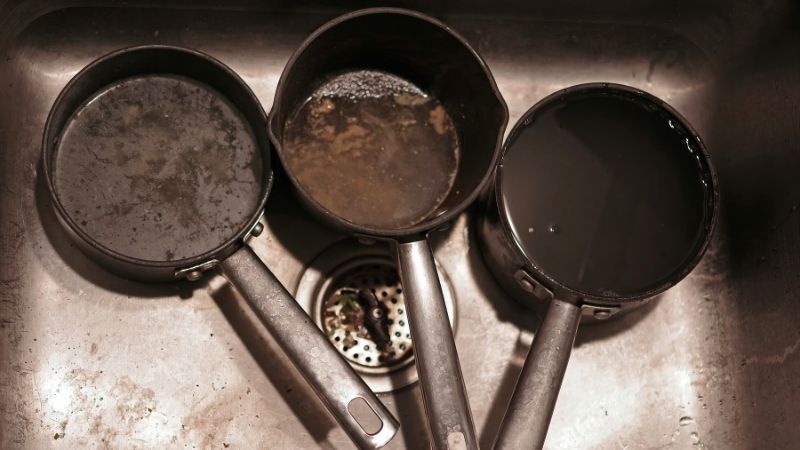Non stick cookware is hugely popular cookware across India and is extensively used. The main reasons behind its acceptance and acclaim include less oil requirement, even heat distribution, durability, allows faster cooking, convenient to use, affordable, saves gas, and easy to clean. The most preferred non stick cookware includes a non stick frying pan, dosa tawa, and kadai. The USP of this cookware lies in its non stick coating which makes cooking sticky food items like eggs, dosa, fish, cheesy dishes, and pancakes; effortless. But like any other form of cookware, even the non stick cookware has its limitations and is susceptible to pitting, scratching, warping, and peeling because of daily usage, washing, wear and tear.
In this article, our endeavour is to upraise you on the perfect technique on how to clean non stick cookware in a step-by-step process, materials used for cleaning, benefits, and how to care for non stick cookware.
Therefore, you can read all the necessary information at one place. Let's get started and get into the details without any further ado.
Materials Required for Cleaning
Non stick cookware is convenient to use and easy to clean. With the help of these materials, you can make the non stick cookware last for many years:
• Warm Water

• Dishwashing Liquid

• Cleaning Sponge

• Baking soda (if needed)

All these materials are easily found in the kitchen or available readily in the market.
Steps on How to Clean Non Stick Cookware
The below-mentioned steps are simple to follow and will guide you in cleaning your non stick cookware in the most efficient yet gentle way. Now let's go through these steps:
1. Cooling Down: After the cooking is complete, allow the cookware to cool down before it can be washed to prevent any harm to the non stick coating.
2. Avoid Dishwashing: The hot water and strong cleaning agents of the dishwasher can warp the non stick cookware. So, hand washing is highly recommended.
3. Warm Water and Soapy Dishwashing Liquid: Submerge the non stick cookware in the wam water mixed with dishwashing liquid.
4. Non Abrasive Sponge: Now, move the soapy cleaning sponge all over the cookware and clean thoroughly by working over the food particles, stains, and spots. Ensure that the sponge is soft and non abrasive to avoid harming the non stick coating.
5. Baking Soda: If the food got stuck at the bottom of the cookware and got burnt, make a paste of baking soda and water and apply it to the burnt area. Leave it for a few minutes, then clean using the soft sponge and water, the burnt area will start to come out neat and clean.
6. Rinse With Water: It's time to thoroughly rinse the cookware properly with preferably running water to wash off all the food particles, smell, dishwashing liquid, and baking soda.
7. Air Drying: Leave the non stick cookware to air dry after thorough washing and cleaning. Now, the cookware will come out shining bright and clean.
8. Avoid Water Spots: After air drying, if you notice water spots on the surface, then make sure to wipe the cookware with a cloth right after some time of air drying to prevent the formation of these water spots.
Now your non stick cookware is clean and ready to be used for cooking another delicious recipe.
Advantages of Using Non Stick Cookware
1. A non stick cookware lets you prepare all kinds of recipes with less oil consumption because of its non stick coating.
2. It reduces the cooking time significantly as compared to other forms of cookware.
3. Most of the sticky food items can be easily prepared in this cookware and the cooked food slides off easily at the end without sticking.
4. It helps to save you some bucks and energy because of less oil usage and quick cooking time respectively.
Tips on How to Care for Non Stick Cookware
These tips and tricks will assist you in maintaining your non stick cookware in a good condition for many years. Let's check all these tips one by one:
- Put your non stick cookware in a dishwasher only if the instructions provided by the brand suggest that it is dishwasher safe.
- In case of peeling or pits of the non stick coating, ensure to discard or replace your cookware.
- Acidic ingredients like lemon and vinegar should not be used to clean as they can deteriorate the non stick coating.
- Avoid storing cooked food in the non stick cookware after cooking and transfer the food to the serving dishes.
Following these tips will ensure that your non stick cookware keeps looking new despite excessive usage.
Final Words
Non stick cookware lets you take a sigh of relief whenever you are in the mood for cooking something quick but delicious as it would not let the food stick at the bottom and burn easily. It is not only trendy but affordable as well which is why it has found its way into almost every Indian kitchen in some or the other way. Now, we are aware of how to clean non stick cookware and care for it in the easiest possible manner. So, keep cooking mouth-watering meals using your non stick cookware and keep them clean and tidy thereafter.

